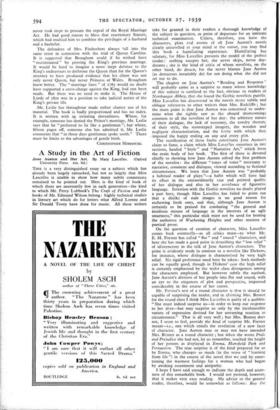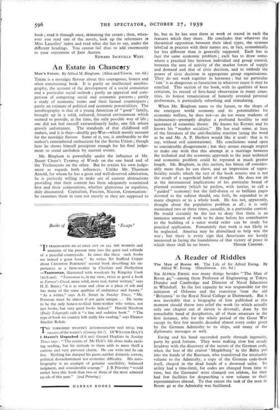A Study in the Art of Fiction
THIS is a very distinguished essay on a subject which has already been largely ransacked, but not so largely that Miss Lascelles is unable to show how many subtle connexions remained to be pointed out. Hers is the kind of book of which there are necessarily few in each generation—the kind
to which Mr. Percy Lubbock's The Craft of Fiction and the books of Mr. Edmund Wilson belong : highly techniCal studies in literary art which do for letters what Alfred Lorenz and Sir Donald Tovey have done for music. All these writers take for granted in their readers a thorough knowledge of the subject in question, as point of departure for an intricate technical examination. Unless, therefore, you have the characters, plots and events of all Jane Austen's novels clearly unravelled in your mind at the outset, you may find this book a humiliating experience. Humiliating but salutary, for Miss Lascelles presents the model of the perfect reader : nothing escapes her, she never skips, never day- dreams ; she is the kind of critic of whom novelists, on the other hand, do dream, for she never blames Jane Austen (as detractors invariably do) for not doing what she did not set out to do.
The chapter on Jane Austen's " Reading and Response " will probably come as a surprise to many whose knowledge of this subject is confined to the fact, obvious to readers of Northanger Abbey, that she found the Gothic novelists puerile. Miss Lascelles has discovered in the novels many subtle and oblique references to other writers than Mrs. Radcliffe ; but the main point is that Jane Austen was concerned to under- mine what she rightly saw as the absurd shortcomings common to all the novelists of her day : the arbitrary nature of their dialogue, the lack of economy, the tawdry rhetoric of their style, the stereotyped imagery, the wooden and negligent characterisation, and the levity with which they t imposed the happy ending on any and every plot.
The rectification of these faults constitutes Jane Austen's claim to fame, a claim which Miss Lascelles examines in two sections, headed " Style " and " Narrative Art," which form the main body of her book. The first of these is devoted chiefly to showing how Jane Austen solved the first problem of the novelist : the different " tones of voice " necessary to narrative, comment and dialogue, viewed according to fictional circumstance. We learn that Jane Austen was " probably a habitual reader of plays "—a habit which will have had its effect in the extraordinarily taut and pointed quality of her dialogue and also in her avoidance of figurative language. Irritation with the Gothic novelists no doubt played a part here, though Miss Lascelles has failed to point out that a dislike of stale images is no good reason for eschewing fresh ones, and that, although Jane Austen is certainly to be praised for combating " the general and insidious misuse of language in the interests of an ugly smartness," this particular stick must not be used for beating the authoress of Wuthering Heights and other masters of poetical prose.
On the question of creation of character, Miss Lascelles comes back eventually—as all critics must—to what Mr. E. M. Forster has called " flat " and " round " characters, and here she has made a good point in describing the " low relief of idiosyncrasy in the talk of Jane Austen's characters. The point is evidently made in contrast to a novelist like Dickens, for instance, whose dialogue is characterised by very high relief. No rigid preference need here be taken : both methods can be equally good, though in Dickens' case the high relief is certainly emphasised by the wider class divergences among the characters employed. But however subtle the method, Jane Austen's division of her people into flat and round, with an eye to the exigences of plot and perspective, improved considerably in the course of her career.
Mr. Forster's test of a round character is that it should be capable of surprising the reader, and in el:liming Mrs. Bennet for the round class I think Miss Lascelles is guilty of a quibble. " She must indeed surprise us—in order to keep our response to her alive—but may surprise us only by the inexhaustible variety of expression devised for her unvarying reaction to circumstance." That is all very well ; but Mrs. Bennet does not, I seem to feel, provide the kind of surprise Mr. Forster meant—i.e., one which entails the revelation of a new facet of character. Jane Austen may or may not have intended Mrs. Bennet as a round character ; but when she wrote Pride and Prejudice she had not, let us remember, reached the height of her powers as displayed- in Emma, Mansfield Park and Persuasion. The true surprise is of the kind prepared for us by Emma, who changes so much (in the sense of " learning from life ") in the course of the novel that we end by enter- taining the warmest feelings for a woman who had begun by awaking resentment and antipathy.
I hope I have said enough to indicate the depth and acute- ness of this remarkable book. I would not pretend, however, that it makes very easy reading. My advice to the general reader, therefore, would be somewhat as follows : Buy the book ; read it through once, skimming the cream ; then, when- ever you read one of the novels, look up the references in Miss Lascelles' index and read what she has to say, under the different headings. You cannot fail thus to add enormously to your enjoyment of Jane Austen.
F.DWARD SACKVILLE WEST.









































 Previous page
Previous page